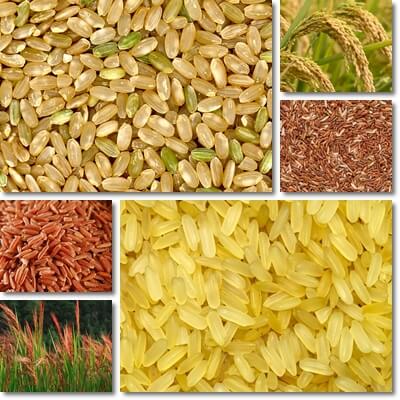What is the glycemic index of rice? What is the glycemic index of different rice varieties? Is there any difference between the glycemic index of plain white rice vs brown rice vs red rice vs black rice? Is there any difference between boiled rice vs raw rice? If you’re diabetic or prediabetic and need to monitor your blood sugar levels more closely, then knowing the GI value of foods you eat all the time, such as rice, can make all the difference when it comes to achieving blood sugar control.
What is the glycemic index?
The glycemic index, or GI, is a numerical scale that classifies foods based on their glycemic impact, or effects on blood sugar. The glycemic index measures how fast, and how much, carbohydrates in food raise blood sugar levels. The GI scale runs from 0 to 100. Foods with a GI score between 0 and 55 are low glycemic, foods with a GI score between 56 and 69/70 are moderate glycemic, while foods with a GI score between 70 and 100 are high glycemic. On the glycemic index food chart, pure glucose is at the very top of the chart with a GI score of 100, while oil, lard and other fats, eggs and pure meat are zero-glycemic foods.

What is the glycemic index of rice?
Rice glycemic index varies from low, under 55, to high, over 90. However, most rice varieties are moderate glycemic with a GI score of over 60 and under 70. The reason the glycemic index of rice is variable to such an extent has to do with the nutritional status of the different rice varieties which changes according to how the rice grains are processed. The more processed the grains, the greater the effects on blood sugar.
As a general rule, white rice is moderate to high glycemic, while brown rice, red rice, purple or black rice varieties are low glycemic to moderate glycemic. White rice is higher glycemic because it’s milled, that is, the husk (or chaff), bran and germ are removed off the grains, leaving the innermost part which is colloquially called ‘white rice’. The milling process removes nutrients such a dietary fiber which would otherwise reduce the effects of the rice on blood sugar.
By comparison, brown rice has only the inedible outer husk removed, leaving the bran and germ, and has less of an impact on blood sugar vs white rice. Varieties such as red rice, purple or black rice are also whole grain rice varieties, meaning the rice grains get to keep their layers, except for the inedible outer husks. Gold rice or golden rice is available both as whole grain and milled, but is often processed similar to white rice.

The glycemic index of white rice
Average GI value is between 64 and 89, but can go higher than 90.
The glycemic index of boiled white rice
Average GI score is between 70 and 80.
The glycemic index of brown rice
Average GI is 56-68, but can go as low as 48 or as high as 78.
The glycemic index of boiled brown rice
Average GI score is between 60 and 68.
The glycemic index of red rice
Average GI is 56-68, but can go as low as 48.
The glycemic index of black (purple) rice
Average GI is 56-68, but can go as low as 48.
The glycemic index of wild rice
GI score ranges between 56 and 69.
The glycemic index of fragrant jasmine rice
Average GI score is 68 to 80, lower in brown jasmine rice and higher in white jasmine rice varieties.
The glycemic index of Basmati rice
Average GI value is 57 to 67-69.
The glycemic index of parboiled rice
Average GI values range from 57 to 72.
Boiled rice vs raw rice glycemic index
Boiled rice ends being lower glycemic than raw, uncooked rice simply because it is usually eaten with other foods, fats and often eggs, cheese and meat, but also sources of fiber such as vegetables, which lower the effects on blood sugar of the rice. The glycemic index value of white rice can drop by 20% to 40% when combined with vinegar, dairy products, and bean products (study).
Note: The glycemic index scores for the different rice varieties presented above are average values. In addition to degree of processing, variety also affects the glycemic index score of rice.
Why does rice glycemic index change between rice varieties?
Amylopectin and amylose are two types of starch in rice. Typically rice is higher in amylopectin which has more pregnant effects on blood sugar compared to amylose. Conversely, varieties of rice higher in amylose affect blood sugar less.
Varieties of rice high in amylopectin, with 80% and up to 100% amylopectin, have the highest glycemic index values. These include glutinous rice, also known as sticky rice, but also plenty of varieties of jasmine rice and medium-grain. Varieties of rice that are naturally higher in amylose have low to moderate glycemic index values. Non-sticky long-grain rice varieties are higher in amylose and affect blood sugar less.
Is rice a low glycemic food?
Rice on the glycemic index table goes from low to moderate to high. For the most part, rice has a moderate to moderately high GI score if you factor in it is not eaten by itself, but with other low and lower glycemic index foods that lower its glycemic score (e.g. fat, meat, eggs, cheese, vegetables). But by itself, rice is often a moderate to high glycemic food, except for a few varieties.
The golden rule is: the less processed the rice grain, the less it affects blood sugar levels. The least processed rice is whole grain rice such as brown rice, red rice and purple rice or black rice. Conversely, the more processed the rice, the more it will raise blood sugar levels. White rice has its nutritious layers removed which causes it to affect blood sugar the most.
Does rice raise blood sugar levels?
Yes, rice does raise blood sugar levels, but how much and how fast it does so depends on how much rice you eat at once (serving size or portion size), how you like to eat rice, including what other foods you pair it with and how you cook it, and your choice of rice variety.
Smaller servings of 30 g and 40 g of rice, uncooked, or half a cup of cooked rice have less of an effect on blood sugar than a plateful of the grain.
White rice is a refined grain – it has the outer husk, bran and germ removed which leaves it almost without fiber to counteract the effects of the carbohydrates in the grain. Yellow rice, also called gold or golden rice, is usually as processed as white rice. By comparison, brown rice, red, purple or black rice are whole grain varieties of rice which preserve the bran and germ and affect blood sugar less.
How you cook rice, what you choose to pair it with, impacts its glycemic value. For example, fried rice is lower-glycemic than plain boiled rice because of the fat added to the rice for frying which slows down the absorption of sugar obtained from the digested carbohydrates in the rice into the bloodstream. Rice with pork, beef or chicken has both fat and protein to reduce its effect on blood sugar. Even rice paired with low GI vegetables ultimately has less of an effect on blood sugar.
